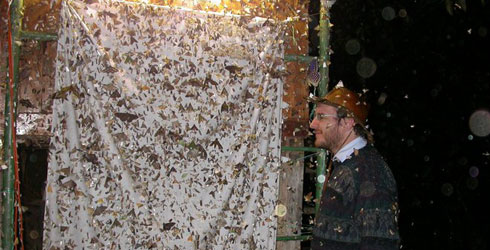Behaviour
Most specimens of Titanus giganteus are collected using mercury vapour UV lights, which are exposed in the rain forest at night - a technique known as light trapping.
Anyone who has left the bathroom window open and the light on during a warm summer’s night will know that the room can fill up with moths, flies and other insects - nocturnal insects are strongly attracted by artificial light, and Titanus is no exception.
They fly at the height of the wet season between December and February and apparently appear at the light sheet rather late at night, usually after midnight. It is possible to collect several specimens in a single night’s light trapping in the right forest, during the right season.
Like many species of insect, it is principally the males that are attracted by light, and there are no records of a female Titanus being collected in this way. Females are very rare in collections (although they are probably as frequent as males in the wild). All known female specimens have been collected by chance - walking along the forest floor, crossing the road, or drowned in a river.
The females probably spend most of their time in decaying subterranean wood where they lay their eggs and where the larvae develop.
Before the advent of electric light trapping, Titanus was considered extremely rare. Jaroslav Mares, a Czech entomologist, tells the story of an explorer in Manaus, Brazil, in the 1910s who was fortunate enough to recover a specimen from the stomach of a large fish which was being prepared for the table.
He apparently enlisted the help of local people to comb the nearby Rio Negro for additional drowned specimens. By this method he accumulated half a dozen or so in various stages of decay. He proceeded to assemble a number of ‘complete’ specimens from them and these were offered for sale to dealers, collectors and museums, who were so keen to get the finest specimens of this great rarity, they met his steamer in the harbour.
